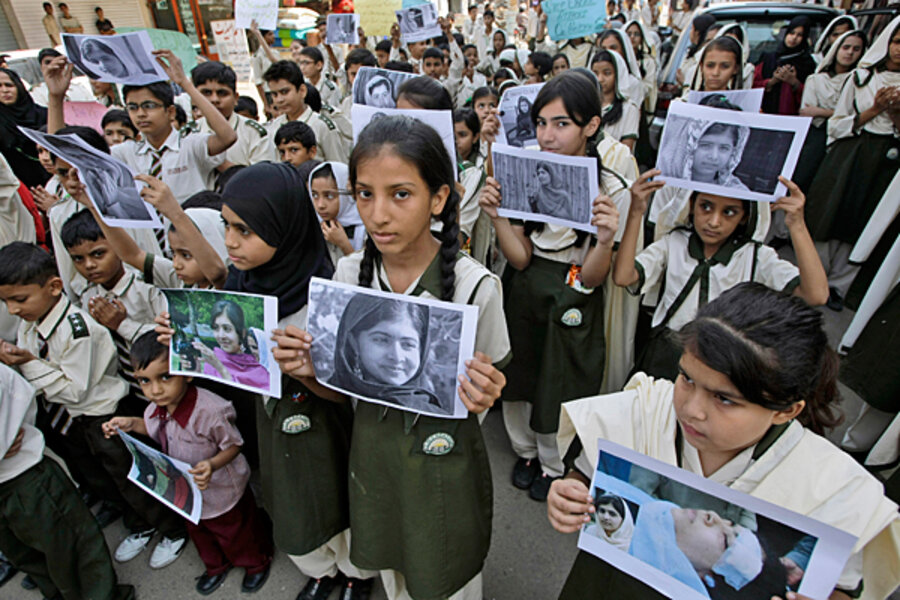Pakistanis debate real enemy: girl-shooting Taliban or drone-firing US
Loading...
| SWAT VALLEY, Pakistan
The news that the Taliban shot a 14-year-old girl for speaking out against them has highlighted a major division in Pakistan over the question of which is worse: the United States or militants?
On one side are civil society members and some ethnic and religious minorities who find the attack on the girl, Malala Yousufzai, atrocious and are calling for action against the Taliban.
“There are many in our valley who would not dare to name the Taliban, but she spoke against them. We cannot deny her sacrifice,” says Khairullah Sina of Swat Valley, who works in the education sector and knows Malala.
Hundreds of protesters from civil society gathered in Islamabad, Karachi, and Lahore to protest the shooting, and have been calling for the Pakistani Army to head up a military operation in North Waziristan to tamp down on militants in the region.
On the other side are the citizens who are criticizing the international community and media for giving her case “more than the attention it deserves.”
There seems to be a concerted effort to tie the Malala incident to the unrelated issue of US drone attacks in Pakistan, says Baqir Sajjad Syed, who writes on foreign affairs and defense issues for the English-language newspaper Dawn.
Sanaullah, a teacher in Swat and an acquaintance of Malala's father, who goes only by one name, says he doesn't understand why international media cares so much about the attack on Malala when there are greater issues that need to be addressed.
"Every time there is a drone attack, innocent children and women are killed. We should also condemn that since it is equally unjust but no one is highlighting it," he says.
The US says it has no other choice than to use drones to rout out militants in areas like North Waziristan, but many Pakistanis complain that it is a violation of sovereignty and causes civilian casualties. It’s an issue that is used often by right-wing Islamists to whip up anti-Americanism.
A couple of days after the Malala incident, Mr. Syed says that his mobile phone inbox was full of text messages imploring him to remember the “war on terror victims like ‘innocent children’ killed by drones.”
He points out that shortly after the attack, right-wing Islamists and most of the Urdu media started asking the question: “Who used Malala?” That question, he says, implies that the US is actually the enemy.
Just as there have been a number of opinion articles praising Malala’s bravery, there have also been doctored images circulating on the Internet. The images of young, injured children falsely claim to be showing drone attack victims. Some have even circulated images of Malala sitting with American officials and have called her a “US agent.”
Military - civilian divides
The divide can also be seen in the military’s response, say analysts
“This is a double game of national security, which the military has played historically,” Syed says, pointing out that the military built its image both locally and abroad by being at the forefront of efforts to provide Malala medical care and also by issuing statements that they were ready to take on the terrorists.
The initial mobilization of civil society in support of Malala sent a message globally that people of Pakistan are not pro-Taliban, says Sarfaraz Khan, who teaches at the Peshawar University. “Initially, even the military responded very positively," he says.
But the civil society and military have now appeared to retreat to two different corners of the debate, and are further divided among themselves.
The military seems to be split over whether it should actually go into North Waziristan and rout out militants. “While the young blood in the military has started calling the Taliban terrorists, the older generation still wants to live in strategic alliances of the ‘80s and '90s, in which we saw the military having close relations with the Taliban in Afghanistan,” says Professor Khan.
Pointing to the lack of consensus in the Parliament about passing a resolution in favor of a North Waziristan operation in light of the attack on Malala, Khan says Parliament is another place the divide is visible.
“Political parties headed by Imran Khan, Nawaz Sharif, and others, whose traditional voting constituencies lie with Islamists and in whipping up anti-Americanism, do not want to lose voters at a time when elections are near, and that is why they are creating a counter public narrative,” he says.





